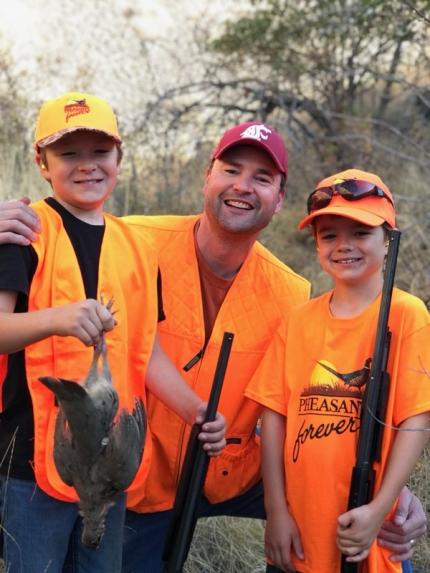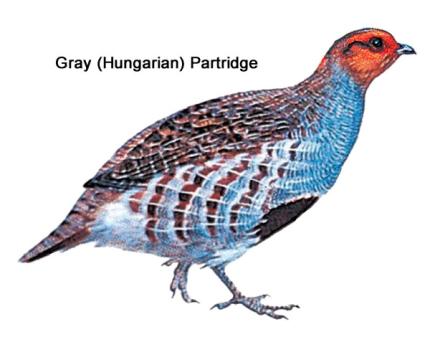
Making their American debut in the late-nineteenth century, these European imports were first released in Washington and California but are now found in huntable numbers in about a dozen Western and Midwestern states and most Canadian provinces. The first birds released in this country came from Hungary, so the gray partridge is also commonly known as Hungarian partridge, or Hun.
Gray partridge, which grow to just over a foot long and weigh about three-quarters of a pound, eat both cultivated grains and a variety of weed seeds, as well as clover and other green, leafy material. As is the case with pheasants and other upland bird species, young partridge feed heavily on crickets, ants, grasshoppers and other insects. They often inhabit the “margins” where agricultural fields and native shrub-steppe habitat meet. Classic Hungarian partridge country might be a field of corn or wheat stubble bordered or intersected by a couple of brushy draws or a gently-sloping hillside dotted with sagebrush. A small stream, pond or wetland nearby would likely make such a spot even more attractive to a covey of Huns.
To most hunters, the gray partridge doesn’t appear very gray at all. That’s because they’re most likely to see the bird’s rust-colored tail and reddish-brown back and wings as it flies straight away from them. If the bird is crossing, you may see the chestnut and gray bars along its flanks. A horseshoe-shaped mark of dark chestnut covers the lower half of the breast.
Like other upland species, young of the year partridge provide most of the fall shooting opportunities. Also like other birds, Hungarian partridge production fluctuates greatly from year to year. A warm, dry spring usually produces a good Hun crop; a cold, wet spring very few, and we have a lot of cold, wet springs here in Washington.
Hunting Strategies
Gray partridge are the least abundant of Washington’s upland bird species, and hunters harvest only about 5,000 gray partridge a year, far fewer than any other upland bird. And, it’s a safe bet that many, if not most, of them are taken incidentally by hunters targeting pheasant, quail and chukar. If you want to hunt Hungarian partridge, though, there are ways to improve your chances.
Huns aren’t as abundant as the other upland species pursued by Washington hunters. Check the most recent Washington State Hunting Prospects publication for harvest information and potential hunting locations. Annual Hun harvest statistics by county can be found on the Small Game: Statewide Totals pages in the Game harvest reports section of the website.
First, cover a lot of ground. You won’t find dozens of birds in any one place; population densities simply aren’t that high, anywhere. Your best bet is to cover miles of decent partridge habitat in hopes of flushing a couple of coveys in a day. A well-conditioned, wide-ranging pointing dog is an immense help, and two well-conditioned, wide-ranging pointing dogs are just about twice as helpful. A gray partridge hunter, of course, must also be well-conditioned and wide-ranging.
Huns like to feed around the edges of grain fields and in patches of seed-bearing weeds and grasses. They tend to roost, hide and rest in hay fields, tall grass, brush patches and along fence lines. All the aforementioned places, then, are good places to look for birds. On windy days they may take shelter behind tree lines, fence rows, boulders, even buildings, or in narrow draws and on lee hillsides.
Huns tend to be more skittish than quail and other upland species, and may run or flush wild when a dog (or hunter) approaches. Some veteran partridge hunters prefer and recommend dogs that are trained to lock up on point as soon as they get a noseful of Hun scent, even if it’s some distance from a bird, rather than get too close and spook birds into flushing out of range. When a dog does lock up on Huns, the hunter should move in fast to shorten the shooting distance before the birds fly.

When flushed, gray partridge usually don’t fly high, but they may fly far, especially later in the season when they’ve had some hunting pressure. What’s more, after they’ve been flushed once, they’re likely to flush farther in front of you or your dog on the second approach, still farther out on the third. In other words, it’s a good idea to do all you can to make your first opportunity count. Although flushed birds usually stay together, the good news is that if you are able to locate singles or doubles after the first rise, they tend to hold better for a dog than coveys will.
Guns and Ammunition
Gray partridge aren’t big or particularly hard to knock down, but they are very good at distancing themselves from the end of a shotgun barrel in a hurry. An ounce and an eighth or ounce and a quarter load of size 6 or 7 ½ lead shot from a 2 ¾-inch 12-gauge shell or 3-inch 20-gauge shell will do the job for the 30- to 45-yard shots you’re likely to get on Huns. If you must decide between a 20-gauge and a half-pound-heavier 12, however, remember that hunting Huns is usually a matter of covering lots of ground in search of widely scattered coveys, and that extra eight ounces of shotgun may feel more like eight pounds by the middle of the day, not only while it’s being lugged around, but when it’s time to shoulder it and swing on a bird.
As for choke, an improved cylinder or modified choke will do the job if your first shot is a close one, but Huns get out to full-choke range quickly. For that reason, a double-barrel gun with a modified/full choke combination might be a good choice for Hungarian partridge.
Shooting
A covey of Huns almost always rises in unison, so job one is to pick out a target and swing on it as quickly as possible. Yes, it may be tempting to “flock shoot” that reddish-brown cloud of whirring wings, but any veteran shotgunner will tell you that rarely produces good results, so lock onto a bird as you shoulder your gun and try to forget that there are any other birds in the air until yours drops (or flies out of range, or your gun is empty). With Hungarian partridge, trying for—or even thinking about—scoring a double usually produces no birds at all.
And remember that, since your target is usually flying straight away rather than quartering or crossing, the best lead is probably going to be under the bird.